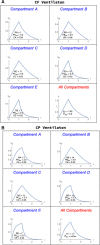Intracycle power distribution in a heterogeneous multi-compartmental mathematical model: possible links to strain and VILI
- PMID: 35641652
- PMCID: PMC9156592
- DOI: 10.1186/s40635-022-00447-6
Intracycle power distribution in a heterogeneous multi-compartmental mathematical model: possible links to strain and VILI
Abstract
Background: Repeated expenditure of energy and its generation of damaging strain are required to injure the lung by ventilation (VILI). Mathematical modeling of passively inflated, single-compartment lungs with uniform parameters for resistance and compliance indicates that standard clinical modes (flow patterns) differ impressively with respect to the timing and intensity of energy delivery-the intracycle power (ICP) that determines parenchymal stress and strain. Although measures of elastic ICP may accurately characterize instantaneous rates of global energy delivery, how the ICP component delivered to a compartment affects the VILI-linked variable of strain is determined by compartmental mechanics, compartmental size and mode of gas delivery. We extended our one-compartment model of ICP to a multi-compartment setting that varied those characteristics.
Main findings: The primary findings of this model/simulation indicate that: (1) the strain and strain rate experienced within a modeled compartment are nonlinear functions of delivered energy and power, respectively; (2) for a given combination of flow profile and tidal volume, resting compartmental volumes influence their resulting maximal strains in response to breath delivery; (3) flow profile is a key determinant of the maximal strain as well as maximal strain rate experienced within a multi-compartment lung. By implication, different clinician-selected flow profiles not only influence the timing of power delivery, but also spatially distribute the attendant strains of expansion among compartments with diverse mechanical properties. Importantly, the contours and magnitudes of the compartmental ICP, strain, and strain rate curves are not congruent; strain and strain rate do not necessarily follow the compartmental ICP, and the hierarchy of amplitudes among compartments for these variables may not coincide.
Conclusions: Different flow patterns impact how strain and strain rate develop as compartmental volume crests to its final value. Notably, as inflation proceeds, strain rate may rise or fall even as total strain, a monotonic function of volume, steadily (and predictably) rises. Which flow pattern serves best to minimize the maximal strain rate and VILI risk experienced within any sector, therefore, may strongly depend on the nature and heterogeneity of the mechanical properties of the injured lung.
Keywords: Flow pattern; Mathematical model; Mechanical power; Mechanical ventilation; Multicompartment; Strain; Stress; VILI; Ventilation mode; Ventilator-induced lung injury.
© 2022. The Author(s).
Conflict of interest statement
All authors declare that no financial or non-financial competing interests are relevant to this paper.
Figures






References
LinkOut - more resources
Full Text Sources

